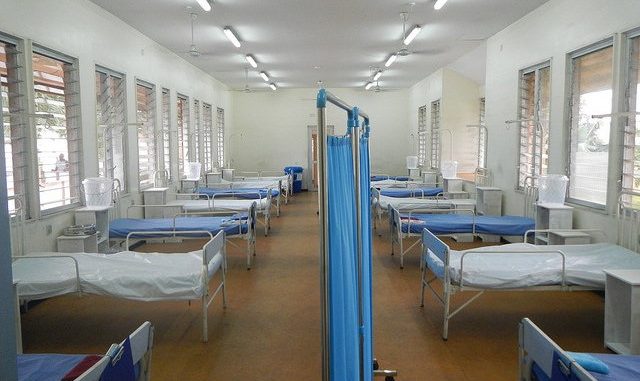
HEALTH AND MEDICINE
How Can ‘Cured’ Ebola Patients Fall Sick Again Months After Recovery?
October 10, 2015 | by Connor Bamford

photo credit: New Ebola isolation ward in Lagos, Nigeria with upgraded facilities readied for patients. Bryan Christensen/Flickr CC BY 2.0
A Scottish nurse infected with Ebola in Sierra Leone last year is now back “in a serious condition” nine months after doctors said she had made a full recovery. Although the exact nature of the condition has not been reported, Pauline Cafferkey’s doctors have detected the Ebola virus and moved her to a specialist isolation unit in London.
The virus is thought to be a re-emergence of her original infection as it is extremely unlikely she was infected again while at home in the UK. Her move to containment is being treated as a cautionary procedure, she is not thought to be contagious and the risk to the public is very low.
You are deemed “cured” from Ebola when doctors can no longer detect virus in your blood using a highly sensitive test yet the virus can survive elsewhere. So how could the Ebola virus return like this?
Making A Comeback
Although little is known about how the Ebola virus causes disease, Ebola is a systemic infection, meaning it can infect cells right across the body. Unlike seasonal flu or hepatitis, which tend to stay within specific parts of the body, Ebola has the capacity to spread to and infect many different organs and tissues.
This is likely due to the virus’s close association with the circulatory system. If cells in the liver are infected they can pump new viruses into the blood stream and if moving immune cells are infected they can make their way to every organ, allowing Ebola to creep its way into nearly every corner of your body.
People die from Ebola if their bodies fail to control its spread, leading to fluid loss and multiple organ failure as the virus damages blood vessels and causes internal bleeding. However, many people eventually turn the tide on the virus and recover. This is probably because their immune systems kick in to eliminate any traces of the virus from the body. This produces anti-viral antibodies that bind to the virus and stop it entering cells, and anti-Ebola cytotoxic T-cells that roam the body searching for – and destroying – infected cells.
But what if these defences can’t reach every Ebola virus and infected cell? Some organs and tissues are considered “immuno-privileged”: the brain, testes, the eye. These are usually places where you would not want a strong immune response and inflammation damaging important bodily functions. If Ebola isn’t cleared from these tissue sites it may result in a long-term infection, giving the virus a long time to grow and multiply without an antiviral immune response.

Pauline Cafferky is in serious condition. Lisa Ferguson/Scotland on Sunday/PA Wire/Press Association Images
We’ve seen the re-emergence of Ebola in this way many occasions before. But previous outbreaks have been very small with few survivors available for study, making detailed research challenging. The most recent outbreak in west Africa was much bigger and spread over a wider area, and many individuals recovered in high-quality hospitals. This means doctors have been able to study the re-emergence phenomenon in more depth.
The best example we have is of the virus coming back in the eye. The first observation of Ebola-associated eye complications appeared over 15 years ago, following the Kikwit outbreak. Four of the survivors complained of swelling in the eye. And in at least one, virus sequence was detected in fluid around the eye.
More recently, Ian Crozier, a clinician from the US, was treated in Atlanta for eye problems.In this case, doctors found Ebola virus inside his eye, nine weeks after he was “cured” of the infection. Three months later, his eye problems subsided and he had recovered. He was treated with an experimental antiviral, anti-inflammatory drugs and steroids.
Ebola, like other acute infections such as measles and chikunguya, has been found to cause long-term health problems associated with apparent persistence of infectious virus. Most dramatic is a fatal and progressive encephalitis called subacute sclerosing panencephalitis or SSPE, which can develop ten years after initial measles infection.
Risk Of Contagion
Critically, doctors have also found Ebola virus inside the eye and in the semen of affected individuals that can spread to and infect cells in the lab. (Importantly, nobody has detected Ebola virus in the brain of infected humans.) This raises the risk that this persistent infection could be transmitted, although little evidence suggests it is found in tears. But, it is unknown whether these viruses could infect and cause disease in people in the real world.
Still, it is better to take this risk seriously. Ebola transmission is most efficient at the peak of symptoms when the virus has grown and there are lots of chances for it to spread through things like vomiting, blood spilling and close-contact nursing.
Although her specific situation is still unclear, Pauline Cafferkey’s body has hopefully built up enough defences to protect herself from the full effect of Ebola. Doctors have proven treatment options that should be able to control the virus.
But Ebola survivors in the worst-affected areas in west Africa will also likely be suffering from the same complications and this issue must be taken into account and addressed on the ground.

Connor Bamford, Post-doctoral Research Assistant, University of Glasgow
This article was originally published on The Conversation. Read the original article.



